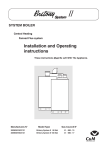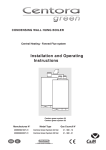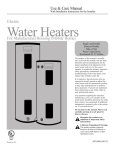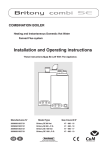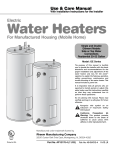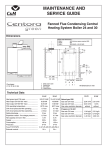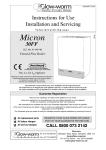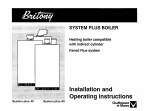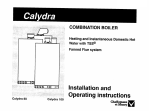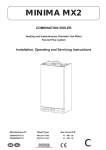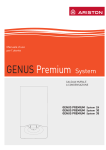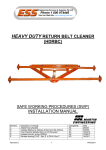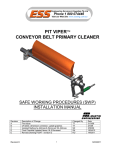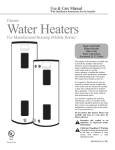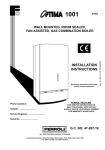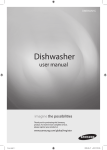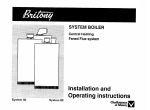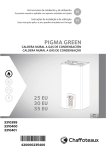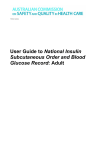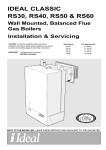Download Calydra Comfort Installation & Operating
Transcript
WALL-HUNG COMBINATION BOILER Central Heating and Instantaneous Domestic Hot Water with TSS® Fanned Flue System Installation and Operating Instructions 2 3 1 4 0 bar 2 3 1 4 0 bar c c Calydra comfort 100 G.C.N: 47-980-21 PLEASE LEAVE THESE INSTRUCTIONS WITH THE END-USER GB IE c These instructions are suitable for the following boilers : Calydra comfort 100 Do not forget the Log Book! Chaffoteaux & Maury supports Benchmark, the heating industry code to ensure the correct installation, commissioning and servicing of domestic central heating systems. To The End User Make sure you have a completed Log Book for your boiler. This provides a record of the commissioning of your boiler. It contains important information about your particular installation that may be required by service engineers. The Log Book will also provide contact details for the installer should you need guidance in the use of this appliance or if there are any problems. As with your car, your boiler will work more reliably and efficiently if regularly serviced. We recommend an annual service check. The service history of the appliance will be recorded on the Log Book. In the unlikely event of any problems with your boiler or system you should first contact your installer. If your installer cannot resolve the problem he should telephone our national service helpline. This appliance is a combined appliance for the production of Central Heating (C.H.) and Domestic Hot Water D.H.W.) This appliance must only be used for the purpose for which it is designed. THe manufacturer declines all responsibility for improper or negligent use. A charge may be made if Chaffoteaux & Maury Service is called out to resolve a non-product related fault. Your statutory rights are not affected. Do not allow children or inexperienced persons to use the appliance without supervision. If you smell gas in the room, do not turn on or off light swithces, use the telephone or any other objects that might cause sparks, open doors and windows to ventilate the room. Shut the gas mains tap (on the gas meter) or the valve of the gas cylinder and call your Gas Supplier immediately. If you are going away for a long period of time, remember to shut the mains gas tap or the gas cylinder valve. Before any intervention within the boiler it is first necessary to isolate the electrical power supply by turning the external switch to “OFF” TO CONTACT C&M SERVICE, PLEASE CALL THE NATIONAL WARRANTY HELPLINE ON: 0870 600 9888 To The Installer As part of the commissioning of this appliance it is vital that the Log Book is completed and given to the End User Please ensure that your customer is aware of the importance of keeping the Log Book safe as a record of the installation and the appliance service history. Please ensure that your customer is aware of the correct operation of the system, boiler and controls. CUSTOMER CARE Chaffoteaux & Maury, as a leading brand of domestic and commercial water heating appliances is committed to providing high quality products and a high quality after sales service. If it is necessary to contact an engineer, then telephone the national warranty helpline 0870 600 9888. Advice on installation or servicing can also be obtained by contacting the Technical Department on: Tel: 0870 241 8180 Fax: 01494 459775 GUARANTEE The manufacturer`s guarantee is for 12 months from the date of purchase. The guarantee is invalidated if the appliance is not installed in accordance with the recommendations made herein or in a manner not approved by the manufacturer. To assist us in providing you with an efficient after sales service, please return the guarantee registration card enclosed with the boiler without delay. STATUTORY REQUIREMENTS The installation of this appliance must be carried out by a CORGI Registered person or other competent person and in accordance with the requirements of the Gas Safety (Installation and Use) Regulations and the rules in force. 2 In GB it is necessary to comply with the Water Supply (Water Fittings) Regulation 1999, for Scotland, The Water Bylaws 2000, Scotland. The Centora Green is an approved product under the Water Regulations. To comply with the Water Regulations, your attention is drawn to The Water Regulations guide published by the the Water Regulations Advisory Scheme (WRAS) gives full details of the requirements. In IE the requirements given under the current edition of I.S.813 must be followed. installation must also comply with the current bylaws of Local Water Undertakings. Installation should also be carried out in accordance with Building Regulations, Local Authority Building Standards (Scotland) Regulations and current editions of the following British Standards Codes of practice: BS 7593, BS 5440 parts 1 and 2, BS 5449, BS 7593, BS 6798, BS 5546, BS 7074, BS 7671 and document IGE/UP/7. In the Republic the Republic of Ireland the installation should be carried out in accordance with the following codes of practice: I.S.813 Domestic Gas Installation, the following BS Standards give valuable information: BS 5546, BS 5449, BS 7074 and BS 7593. The electrical connections must be made in accordance for GB with current I.EE. Wiring Regulations, in Scotland with the electrical provisions of the Building Regulations applicable in Scotland, the Safety Document 635 The Electricity at Work Regulation and in the Republic of Ireland in accordance with I.S.813 and the current ETCI rules. The Centora Green does not contain any asbestos or asbestos products, or mercury derivatives. Additional CFC’s have not been used in this product.The appliance does not contain any potential hazard in relation to the COSHH regulations. If there is a possibility of the incoming mains water pressure exceeding 10 bar then a suitable pressure limiting valve must be fitted where pressures exceed 6 bars a pressure limiting valve is preferred. Precautions: During servicing, keep the dust generation to a minimum and avoid inhaling any dust and contact with the skin and eyes. Normal handling and use will not present any discomfort, although some people with a history of skin complaints may be susceptible to irritation. When disposing of the ceramic lining, ensure that it is securely wrapped and wash hands after contact. Contents Page CUSTOMER CARE ............................................. Guarantee............................................................ Statutory Requirements...................................... Contents .............................................................. INTRODUCTION ................................................. DESCRIPTION .................................................... Location of components ...................................... TECHNICAL DATA.............................................. DIMENSIONS...................................................... OPERATION ....................................................... Domestic Hot Water Mode .................................. Central Heating Mode.......................................... INSTALLATION REQUIREMENTS ..................... Location ............................................................... Flue...................................................................... Ventilation............................................................ Gas Supply .......................................................... Electrical Supply .................................................. INSTALLING THE BOILER ................................. Installation ........................................................... Fitting the horizontal flue ..................................... Making the electrical connections........................ SYSTEM GUIDANCE.......................................... 1 2 2 2 3 3 4 4 5 6 7 7 7 8 8 8 8 8 8 9 9 9 10 11 Showers............................................................... Flushing and Water Treatment ............................ System Controls .................................................. By-pass and pump............................................... Expansion Vessel ................................................ Filling Point .......................................................... COMMISSIONING AND TESTING ..................... Pre-commissioning .............................................. Domestic Hot Water ............................................ Central Heating.................................................... Lighting the boiler ................................................ Post Commissioning............................................ Handing over to the Householder........................ USER INSTRUCTIONS....................................... Control panel ....................................................... Isolating taps ....................................................... Switching on ........................................................ Hot water ............................................................. Heating ............................................................... Turn off the boiler ................................................ INSTRUCTIONS FOR SETTING THE BUILT-IN CLOCK ................................................................ GAS CONVERSION............................................ INCORRECT OPERATION ................................. Page 11 11 11 11 11 11 12 12 12 12 12 12 12 13 13 13 13 13 13 13 14 15 15 Introduction By combining their modern highly efficient low water content fanned flue combination boiler concept and the brand new TSS®“Temperature Stabilised System”, Chaffoteaux & Maury have created a whole new concept. Calydra comfort This unique combination is able to provide the user with hot water immediately at the outlet of the appliance and stable temperatures at both extremely low flow rates or when several taps are opened together. The TSS® is a 5 litres, independently controlled mini unvented storage cylinder, powered by a 3 kW coil. It works in 3 conjunction with the Chaffoteaux & Maury low pressure instantaneous domestic hot water system. The ‘Calydra comfort’, as well as providing hot water, provides central heating. The boiler is designed for sealed systems only. A one speed circulating pump, diverter valve, expansion vessel as well as a pressure gauge and safety valve are included within the boiler. The ‘Calydra comfort’ provides the advantages of mains pressure hot water to taps and showers. Supplied directly from the main water supply the ‘Calydra comfort’ does not need a separate feed cistern or vent pipe in the loft space. The ‘Calydra comfort’ has been tested and approved by the WRc as meeting with the requirements of the Water Regulations Authority. The boiler has been tested and approved to carry the CE mark. The ‘Calydra comfort’ can be installed with the standard horizontal flue, raised horizontal, concentric vertical, twin pipe flue or SEduct arrangements. Adapters, bends and other accessories are available on request. The boiler is packed in TWO cartons: 1. The boiler. 2. The flue assembly and fixing kit. 2 Description K 1 Location of components 1 - Air pressure switch 2 2 - Steel chassis complete with expansion vessel 3 - Flue hood with fan 4 - Main heat exchanger 11 3 4 5 - Combustion chamber 6 - Multi- gas burner assembly including ignition and ionisation electrodes 7 - Pump 8 - Central Heating flow switch 5 9 - Automatic air separator and automatic vent 10 - D.H.W. detector 11 - Sealed chamber 6 14 13 7 12 Fig. 1 15 20 9 16 17 10 8 19 18 22 Fig. 2 4 21 12 - Electrical box 13 - Overheat safety cut-out 14 - Gas valve assembly 15 - TSS ® (mini cylinder) 16 - Central Heating control thermistor 17 - Three way valve 18 - TSS® control thermistor 19 - Domestic Hot Water flow switch 20 - Secondary heat exchanger 21 - D.H.W. pressure relief valve 22 - Isolation valves support bracket 23 - On/Off switch OFF «O» ON «I» 24 - Domestic Hot Water temperature adjustment 25 - Heating flow temperature control knob 26 - Heating temperature indicator lights 27 - Green indicator - Power ON 28- Orange indicator - Burner ON 29 - Red indicator - Lock out / flame failure 30 - Reset button 31 - Pressure gauge 32 - D.H.W. mode indicator 33 - Central Heating mode indicator K - Flue kit fixing point (refer to kit manual) 29 30 26 28 27 reset 33 32 I Fig.3 25 31 23 24 Technical Data 3 Calydra comfort 100 Appliance category Calydra comfort 100 Propane L.P.G. G31 Cat Ii 2H 3+ Gross heat input C.H. & D.H.W. 34.6 Maximum in kW Maximum in Btu/h 117,900 Gas rate Maximum in kg/h Maximum in ft3/h 2.42 44.8 Heat output C.H. & D.H.W. Maximum in kW Maximum in Btu/h 28 95,600 Inlet pressure Nominal in mbar Nominal in in wg 37 14.8 85° C 35° C Burner pressure Nominal in mbar Nominal in in wg 30.4 12.2 C.H. operating temperature Max: Min: C.H. circuit pressure Min operating in bar in lb/in2 Max operating in bar in lb/in2 0.7 10 2.5 36.3 D.H.W. flow rates @ ∆T 30oC in l/min in gal/min @ ∆T 35oC in l/min in gal/min 13.9 3.06 11.9 2.62 Cold water mains pressures Min operating in bar in lb/in2 Max operating in bar in lb/in2 Flow limiter rate in l/min Compartment ventilation not 0.5 7.25 10 145 10 required Natural Gas G20 Gas rate Maximum in m3/h Maximum in ft3/h 3.29 116 Inlet pressure Nominal in mbar Nominal in in wg 20 8 Burner pressure Nominal in mbar Nominal in in wg 12.8 5.1 Burner injector diameter Natural Gas G20 in mm 1.28 Butane L.P.G. G30 Gas rate Maximum in kg/h Maximum in Lbs/h 2.45 5.40 Inlet pressure Nominal in mbar Nominal in in wg 28 11.2 Burner pressure Nominal in mbar Nominal in in wg 24 9.6 Burner injector diameter L.P.G. G30 and G31 in mm 0.76 Safety discharge in bar in lb/in2 3 43.5 Expansion vessel Pre-charge pressure in bar 0.7 Pre-charge pressure in lb/in2 10 Nett capacity at 3 bar in litres 6 Automatic by-pass Electrical characteristics Supply Consumption Protection Fuse n°1 Fuse n°2 External controls 230V~ 150 W IP4 XD 2A 1.25 A 24V~ 5 4 Dimensions Outer case dimensions : 440 (minimum space required 450) - Width : - Height : 850 380 - Depth : Minimum clearances : All dimensions in mm 360 260 50 50 - Both sides 5 mm - Above casing 170 mm - Below casing 200 mm - Front ( for servicing) 500 mm 212 - Front (in operation) 5 mm 738 850 Safety valve centre line The boiler is suitable for the 3 flue types: 380 • Type C 12 or C 42 • Type C 32 xx • Type C 32 xy 54 54 54 54 68 J K L M N I Ø 80 Ø 80 120 Ø 80 Ø 125 Ø 100 143 250 206 Type C 12 Type C12, C42 250 Type TypeCC32 32xxxx Type 32 xy xy Type C C 32 Fig. 4 Weights Tails diameter With packaging : - Calydra comfort 100 : 40.5kg Without packaging : - Calydra comfort 100 : 38.5kg Lift weight : - Calydra comfort 100 : 6 32.5kg I Safety valve outlet J Central Heating flow K D.H.W. outlet L Gas supply M Cold water inlet N Central Heating return ø 15 mm ø 22 mm ø 15 mm ø 22 mm ø 15 mm ø 22 mm 5 Operation 29 30 26 28 27 reset 33 I Fig.5 25 31 24 Domestic Hot Water Mode In order to supply hot water, the main switch 23 (Fig.5) must be in the ON position I This will be confirmed by the green indicator light 27 (fig. 5). Turn the D.H.W. temperature adjustment knob 24 clockwise to establish the green D.H.W. indicator 32 (Fig.5). The hot water temperature in the mini cylinder can be adjusted between 40 and 60°C using the control knob 24 (Fig.5). When a tap or shower is turned on, the flow of mains water, above 2 l/min, will activate the 3 way valve 17 (Fig.2) to move to the D.H.W. position. The pump will now circulate primary water heated by the main heat exchanger through the secondary heat exchanger. The first stage solenoid a (Fig.6) and the safety solenoid c (Fig.6) open together to allow gas to the burner. The ignition sequence begins and a continuous high speed spark ignites the gas. As soon as a flame is detected the orange indicator 28 (Fig.5) will light and the second stage solenoid b bulb (Fig.6) opens to allow the full gas rate. If a flame is not detected, after 8 seconds, the security solenoid closes and 29 shuts off the gas. The red lockout indicator bulb 32 23 (Fig.5) will show. Over 2 l/min, the D.H.W. temperature is controlled by the D.H.W. control thermistor d (Fig.6) and the heating control thermistor e (Fig.6), but dependant upon the position of the D.H.W. temperature adjustment knob 24 (Fig.5). This system anticipates the changes of temperature in the secondary heat exchanger and ensures accurate temperature regulation. When the tap is closed the burner is extinguished and the pump stops. (unless the TSS® thermistor is calling for heat, in which case the burner will remain on at a low rate and the pump will continue running until the mini cylinder thermistor is satisfied). The boiler will now stay in the hot water mode for 30 seconds to be ready for a subsequent draw off Priority is given to a demand for hot water. This will interrupt the central heating for the duration of hot water delivery or recovery of the mini cylinder. When the boiler has been in standby in hot water mode for some time or when drawing D.H.W. at flow rates of less than 2 l/min the temperature in the mini cylinder will eventually decrease and the TSS® control thermistor f (Fig.6) will call for heat, Causing the pump and burner to operate, until the TSS® thermistor is satisfied. Central Heating Mode To be able to supply heating, the main switch 23 (Fig.5) must be in the I position. This will be confirmed by the green indicator light 27 (Fig.5). Turn the temperature control knob 25 clockwise to establish the green heating indicator 33 (Fig.5). f a b c e Fig. 6 d When there is a demand for heating (either from the room thermostat or the clock) and the boiler temperature control is calling for heat. The pump starts allowing the ignition sequence to begin. The first stage solenoid a (Fig.6) and safety solenoid c (Fig. 6) open together to allow gas to the burner. The ignition sequence begins and a continuous high speed spark ignites the gas. As soon 28 (Fig 5) will as a flame is detected the orange indicator bulb light. After 45 seconds the second stage solenoid b (Fig 6) opens to allow the full gas rate. If a flame is not detected, after 8 seconds, the security solenoid closes and shuts off the gas. The red lockout 29 (fig. 5) will show. indicator bulb The central heating flow temperature is controlled by the central heating control thermistor e (Fig 6). The boiler has been designed to minimise cycling and will not attempt to relight for at least 3 minutes after the boiler thermostat has been satisfied (it is possible to reduce the time to 30 seconds if necessary). When the room thermostat is satisfied the burner will switch off and the pump will remain running for a further 4 minutes before it to stops. NB : It is possible to override the 3 minute delay by pressing the RESET button 30 (Fig 5). 7 6 Installation Requirements Location The boiler can be installed on any suitable internal wall. Provision must be made to allow the correct routing of the flue and siting of the terminal to allow the safe and efficient removal of the flue products. A compartment or cupboard may be used provided that it has been purpose-built or modified for the purpose. It is not necessary to provide permanent ventilation for cooling purposes. Detailed recommendations are given in BS 5440 pt 2. If it is proposed that it is installed in a timber framed building then reference must be made to British Gas Document DM2, or advice sought from CORGI. Ventilation The room in which the boiler is installed does not require specific ventilation. If it is installed in a cupboard or compartment permanent ventilation is not required for cooling purposes. Gas Supply The gas installation and soundness testing must be in accordance with the requirements of BS 6891.The boiler requires a minimum 22 mm supply. (Ensure that the pipe size is adequate for demand including other gas appliances on the same supply). Flue Electrical Supply The appliance requires an earthed 230V - 50 Hz supply and must be in accordance with current I.E.E. regulations. It must also be possible to be able to completely isolate the appliance electrically. Connection should be via a 3 amp fused double-pole isolating switch with contact separation of at least 3 mm on both poles. Alternatively, a fused 3 Amp. 3 pin plug and unswitched socket may be used, provided it is not used in a room containing a bath or shower. It should only supply the appliance. Detailed information on the flue assembly is contained in the appropriate starter pack. The boiler must be installed so that the flue terminal is exposed to the free passage of external air at all times. It must not be allowed to discharge into another room or space such as an outhouse or closed lean-to. The minimum acceptable clearances are shown below: - A Directly below an opening, window, etc 300 mm - B Above an opening, window, etc 300 mm - C Horizontally to an opening, window, etc 300 mm - D Below gutters, soils pipes or drain pipes 75 mm - E Below eaves 200 mm - F Below balconies or car port roof 200 mm - G From a vertical drain pipe or soil pipe 150 mm - H From an internal or external corner 300 mm - I Above ground roof or balcony level 300 mm - J From a surface facing the terminal 600 mm - K From a terminal facing the terminal 1200 mm - L From an opening in the car port into the dwelling1200 mm - M Vertically from a terminal on the same wall 1500 mm - N Horizontally from a terminal on the same wall 300 mm - Q Fixed by Ubbink Rolux 4 GM flue terminal It may be necessary to protect the terminal with a guard. Reference should be made to the Building Regulations for guidance. Suitable guards may be obtained from the following manufacturer: Quinnel Barret & Quinnel Wireworks Old Kent Road London SE15 1NL Tel: (020) 7639 1357 Q Q I Q D,E F J B G A I Fig. 7 8 N C L M N H H M K 7 Installing the Boiler Please check that you are familiar with the installation requirements before commencing work.(section 6) Method of Positioning the Boiler on The Wall. The paper template can be used to ensure the correct positioning of kitchen cabinets etc. It also details the commissioning instructions. The paper template has to be fixed to the wall and used to locate the position of the hanging bracket and the centre for the flue hole. Drill and plug the wall and secure the hanging bracket using the screws provided. Remove the boiler from its packaging as shown in Fig.8 and remove the outer case as shown in Fig.9. 2 3 1 4 0 bar Fig. 8 A A A A Fig. 9 Fig. 10 L Place the boiler on the wall on the hanging bracket. Using (Fig.4) for reference, connect the gas and water pipes and the valves to the base of the appliance using the tails provided. There is a space of 190 mm between the valves and the wall to make these connections. Connecting the Boiler to the System Attention ! Connecting tails are delivered with the boiler. You could ask your local dealer or Chaffoteaux et Maury Ltd for first installation tails kit or to replace existing boilers such as old Chaffoteaux et Maury models. Before fitting the tails onto the connecting bracket, please check the correct location of the flow restrictor L (fig.10) on the main inlet. Safety Valve Drains The pressure relief valve tube is clear silicone. It should terminate below the boiler over a tundish or 22 mm pipe (see I Fig 4) which should in turn discharge safely outside the premises. Care should be taken that it does not terminate over an entrance or window or where a discharge of heated water could endanger occupants or passers by. The system should be carefully checked for leaks, as frequent refilling could cause premature system corrosion or unnecessary scaling of the heat exchanger. Fitting the Horizontal Flue The instructions for the vertical and biflux (twin pipe) flue options are included with the relevant adapter kits. The standard flue supplied with the appliance is suitable for lengths from 300 mm minimum to 720 mm maximum. This means for rear flueing, the standard kit will accommodate a maximum wall thickness of 600 mm, and for side flueing a maximum wall thickness of 587 mm. This takes into account the minimum appliance side clearances of 5 mm. If the fixing is a rear exit flue, the template provides the position of the centre for drilling the flue hole with a core drill. If the flue is a side exit installation then calculate the position of the hole with a slope of 5 mm / metre away from the boiler to the terminal. The flue should fall slightly to the terminal. 9 Installing the Boiler (contiunued) 8 S Room thermostat T.A. J1 J2 Connector D Mains supply cable Fig. 11 P3 Making the Electrical Connections: C E P4 Connect the live and neutral wires of the main cable. Note: The connections should be made so that should the lead beP5pulled from its anchorage, the current carrying wires become taut before the earth wire. If using a room thermostat or other external control, undo the two retaining screws B, remove cover C (Fig.12), they can be connected in place of the link on the multipin plug.D. Connect the multipin plug into the socket on the power board. Replace the cover. TAT THERMOS B Fig. 12 J11 ADJUSTMENT 1 2 J2 C10 J5 C38 J1 R75 R76 HOR R73 MV1 (P3-P4-P5) P3 Fig. 13 Choice of Boiler Operation : In order to make these adjustments you will need to access the R85 F1 F1A front of the electrical box. Isolate the mains electrical supply to boiler. Remove the boiler outer casing. Remove the rubber cover E (Fig.12) on the front of electrical box. R67 Detail P3 1/3 Adjustment on the PCB Central Heating Mode (Fig.13) : P3 3/3 - P3 : potentiometer TAC (Temporisation Anti Cycle) may now be adjusted between 30 seconds and 3 minutes (see detail) (factory set at 3 minutes). - JP3 : the spade connector (Fig.14) allows the gas rate to be reduced to 1/3 performance by positioning the spade across the pins as shown (Fig.14). Full performance across pins as shown (Fig.14). After completing the adjustments replace the rubber cover and refit the outer casing. Fig. 14 10 L maxi N mini J10 1/3 Choice of Mode : - Function without room thermostat, bridge S remains in place. - Function with room thermostat, remove bridge S, room thermostat connected as shown on connector D (Fig.11). The external control switches both burner and pump. The external control switches the pump off after a delay of 3 min 30 seconds C11 P3 R72 P3 9 System Guidance The boiler is suitable for sealed systems only. The maximum cold water mains pressure for the appliance is 10 bar. All fittings and pipework connected to the appliance should be of the same standard. If there is a possibility of the incoming mains pressure exceeding 10 bar, particularly at night, then a suitable pressure limiting valve must be fitted. Fernox Manufacturing Britannica Works Clavering Essex CB11 4QZ Tel: (01799) 550811 The boiler is designed to provide hot water on demand. If there is a requirement for greater demands, for example if the property has several bathrooms and cloakrooms, a vented or unvented hot water storage system should be used. System Controls The boiler is electrically controlled and is suitable for most modern electronic time and temperature controls. The addition of such external controls can be beneficial to the efficient operation of the system. The boiler connections for external controls are 24V and so only controls of 24V or that have voltage free contacts should be used. Showers Any shower valves used with the appliance should be of a thermostatic or pressure balanced type. Refer to the shower manufacturer for performance guidance and suitability. By-pass and Pump The boiler is fitted with an automatic by-pass. . Flushing and Water Treatment Expansion Vessel The performance of the appliance could be impaired by system debris or the effects of corrosion. The system must be flushed thoroughly to remove metal filings, solder, machining oils and other fluxes and greases before connecting the boiler. If it is an existing system, an appropriate flushing and descaling agent should be used. Refer to BS 7593: 1992 for guidance. For more information on the use of corrosion inhibitors, flushing and descaling agents, advice can be sought from the manufacturers of water treatment products such as: The expansion vessel is pre-charged to 0.7 bar (10 lb/in2). The vessel is suitable for systems up to 145 litres capacity. For systems of greater capacity an additional expansion vessel will be required. Refer to the chart below and BS 7074 pt 1 or BS 5449. Filling Point Provision must be made to be able to charge the system on commissioning and to make up any subsequent pressure loss. The method of connection must utilise approved equipment and must comply with the water regulations. A filling loop can be installed so as to be hidden beneath the boiler. Betz Dearborn Ltd Foundry Lane Widnes Cheshire WA8 8UD Tel: (0151) 424 5351 Pf Pression à froid pour le circuit chauffage (en bar) Pressure System capacity chart 2,0 1,9 1,8 1,7 40°C 1,6 1,5 1,4 50°C 1,3 1,2 60°C 70°C 1,1 1,0 0,9 0,8 0,7 Fig. 15 80°C 20 40 60 80 100 120 140 160 180 200 220 240 260 Capacité maximale de l'installation (en litres) Liters 11 10 Comissioning and Testing Pre-commissioning Ensure that the system has been adequately flushed. Purge gas supply of air and test for soundness. Carry out final electrical tests to ensure the correct polarity and earthing continuity. D.H.W. Open the main cold feed valve. Open all hot taps to purge the D.H.W. system. Check for water soundness. Check flow rate at the bath tap is set correctly (see technical data). Central Heating Open flow and return valves on the boiler 34 and 38 (Fig.16) Open the automatic air vent 9 (Fig.16) Fill system and vent radiators. Set system pressure and remove filling loop. Check for leaks. Manually check pump is free to turn. Switch on electrical supply. Turn selector switch 23 (Fig.17) to position I Turn the boiler thermostat to maximum. Allow pump to run for several minutes. Isolate electrical supply. Drain boiler and check water filter for installation debris. Replace filter and recharge system. Lighting the Boiler Connect gas pressure gauge to test point 14 (Fig.16). Turn on the gas supply and boiler gas tap 36 (Fig.16). Ensure electrical supply is on. Ensure all external controls are calling for heat. gauge to test point 14 (Fig. 16) (working pressure) while boiler is operating in hot water mode. (Refer to technical data). Check the operation of the boiler controls and safety devices.(see separate servicing leaflet for details) Set the by-pass (Refer to system guidance). Re-flush the system to remove any dissolved oils and fluxes. Recharge system pressure and introduce any water treatment as required. Post Commissioning Ensure system pressure has been set correctly. Set boiler thermostat and controls. Set programmer to End Users requirements. Set external controls. Ensure the Log Book is fully completed with your contact details and required readings and details of the installation. Handing Over to the End User Demonstrate the lighting and operation of the boiler. Demonstrate how to maintain the system pressure. Demonstrate the operation and setting of the built-in clock. Explain the benefits of annual maintenance by a competent person. Explain how to register guarantee. Ensure the End User countersigns the Log Book to confirm that these demonstrations have been carried out and understood. Turn selector switch 23 (Fig.17) to position I. Turn the boiler thermostat to maximum 25 (Fig 17). The boiler will light. Allow the boiler to heat system. Check the inlet gas pressure by connecting a gas pressure 14 Detail for the adjustment of the by-pass 9 Isolating screw on - : by-pass shut E 40 34 35 Isolating screw on + : by-pass open 42 36 37 41 E P Fig.16 12 38 39 P User’s Instructions 11 Control Panel (Fig.17) 31. Pressure gauge 23. Two position selector switch O = Switched OFF I 32. =- D.H.W. mode indicator 33. =- Central Heating mode indicator = Switched ON 24. = Domestic Hot Water temperature control knob 25. = Central Heating flow temperature control knob Isolating Valves (Fig 16) Valves shown in open position 26. Central Heating temperature indicator lights 34. C.H. flow isolating valve 27. Green indicator - Power ON 35. Domestic Hot Water outlet 28. Orange indicator - Burner ON 29. Red indicator - Lock-out/flame failure 36. Gas service valve 37. Water service valve 38. C.H. return isolating valve 30 “RESET” Reset button 29 30 26 28 27 reset 33 Fig.17 I 31 25 Switching on 32 23 24 Heating 1) Check that the gas service valve is opened at the gas 1) Turn mains switch 23 to on position I . The green "power meter and mains power is on. on" indicator will light 27. 2) Check that pressure in Central Heating system is above Turn the C.H. temperature control knob clockwise 25. The 0.7 bar and below 1.5 bar with the pressure gauge 31. C.H. indicator will light 33. 3) Open the gas service valve 36. 3) If the room thermostat (if fitted), the boiler temperature 4) The boiler is now ready to use. control Hot Water and the heating will be on. and the clock (if fitted) are all calling for heat, the orange "burner on" indicator will light 1) Turn mains switch 23 to position I . The green "power on" When there is a need for hot water while the heating is on, it indicator 27 is only necessary to turn on a hot tap. The heating will be will light. Turn the D.H.W. temperature control knob clockwise 24. interrupted momentarily while the hot water is being The D.H.W. indicator will light 32. delivered. The boiler will switch back automatically to 2) Turn on a hot water tap, the orange "burner on" indicator heating when the tap is turned off. will light 28 and the water will become hot. Note: If the boiler has been turned off for some time the first attempt to light it may result in a lock-out If this happens press the reset button 30 and the boiler will light. To Turn Boiler Off Completely 1) Turn the main switch 23 to the off position O. 2) Turn the gas service valve 36 OFF. 13 Helpful suggestions - Periodically check the system pressure using the pressure gauge and make sure that the pressure is between 1.0 and 1.5 bar when the system is off and cool. If the pressure is below the minimum recommended value, the pressure must be brought into the acceptable range. Consult your installer for checking and refilling the system. If the pressure level drops on a frequent basis, it is likely there is a water leak in the system. If this is the case, your installer must inspect the system. - The outer panel of the boiler’s case must only be cleaned with a damp cloth, do not use abrasive cleaners. The control panel can be wiped with either a damp or dry cloth. Spray polishes must not be used on the control panel surface or knobs. Care must be taken in preventing any liquid entering the appliance. - If the water is exceptionally hard, install a water softerner so that the efficiency of the boiler remains the same over time as this will consume less gas. 12 Instruction for Setting the Built in Clock 1. General Layout The mechanical clock covers a 24 hour period. Each tappet represents 15 minutes A (Fig.19). An override switch is located on the clock B (Fig 19). 2. To Set the Time To set the time of day, grasp the outer edge of the dial and turn slowly clockwise until the correct time is lined up with the arrow C (fig. 19). 3. To Set the "On" and "Off" Times The clock uses a 24 hour system. (e.g. 8 =8.00 am and 18 = 6.00 pm) "ON" periods are set by sliding all tappets between the "ON" time and the "OFF" time to the outer edge of the dial.The tappets remaining at the centre of the dial are the "OFF" periods. Fig.18 4. To Select Function Mode Put the selector switch B to symbol to control the boiler by the clock. Put the switch B to «I» to select permanent operation or to «0» to turn heating off permanently. A 2 4 3 1 24 23 22 12 5 21 C 6 7 19 9 20 I 8 18 9 17 6 B 16 15 14 13 10 12 11 Fig.19 14 13 Gas Conversion This appliance is suitable for Natural gas or LPG. A gas conversion must be made by a competent person. 14 Incorrect Operation Fault Cause The boiler doesn’t start No gas, no water or no electricity Solution Check the water pressure in the central heating system and external electrical supply, check that the gas supply is on, should there still be a problem contact your local service centre. Air in the gas pipe Contact your local service centre. Room thermostat switched off Turn up the room thermostat Wait for a few minutes Press the reset button 36 (fig.21) the red led will go out and the boiler attempts to re-light. If the red indicator lights too frequently, please call your local service centre. Red indicator alight Ignition lockout Noises in CH system Air presence in CH system or. Insufficient pressure Purge of air the system and rise up the system pressure (chapter 8) Radiators rise in temperature During summer season Gravity effect in the CH system Close the heating flow isolating valve. Don’t forget to open it again when you will start heating. If these solutions do not cure the fault, call a qualified professional Notes 15 This appliance is suitable for Natural gas or LPG. A gas conversion must be made by a competent person. Manufacturer: Chaffoteaux & Maury - France Commercial subsidiary: MTS (GB) Limited MTS Building Hughenden Avenue High Wycombe Bucks HP13 5FT Telephone: Fax: Internet: E-mail: (01494) 755600 (01494) 459775 www.chaffoteaux.co.uk [email protected] Technical Support Help Line: Customer Service Help Desk: 0870 241 8180 0870 600 9888 1309145 - 02/2002 Chaffoteaux & Maury are continuously improving their products and therefore reserve the right to change specifications without prior notice and accepts no liability for any errors or omission in the information contained in this document.
















